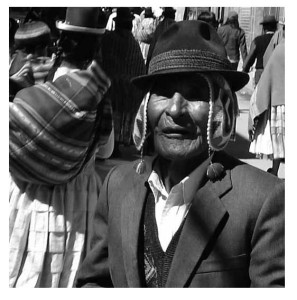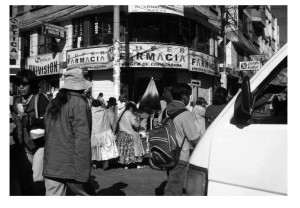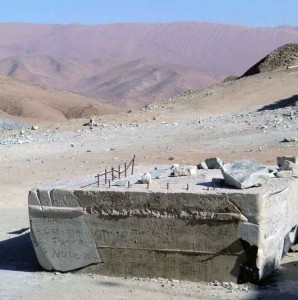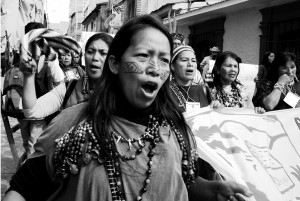Van yatiri tot privékliniek – Interculturaliteit in de gezondheidszorg in Bolivia – deel 1
Toegang tot goede gezondheidszorg is een belangrijke basisbehoefte. Maar wat is goede gezondheidszorg? Als wij in Nederland ziek worden, hebben we er in de meeste gevallen wel vertrouwen in dat onze huisarts of een specialist in het ziekenhuis ons weer geneest. We begrijpen min of meer hoe het zorgsysteem in elkaar steekt, en hoeven ons over de kosten van de behandeling nauwelijks zorgen te maken omdat we verzekerd zijn. Als we in het buitenland zijn, wordt de situatie al lastiger. De arts spreekt onze taal niet en we weten niet hoe het systeem werkt. Hetzelfde geldt natuurlijk voor immigranten in Nederland die het Nederlands nog niet goed beheersen.
Dit soort problemen speelt ook in andere landen met een cultureel diverse bevolking. Voor de inheemse inwoners van ontwikkelingslanden kan het Westerse zorgsysteem vreemd, onbegrijpelijk en angstaanjagend overkomen. In veel gevallen vertrouwen zij liever op hun eigen inheemse geneeskunde, vaak uitgevoerd door medicijnmannen en -vrouwen. Read more
Van yatiri tot privékliniek – Interculturaliteit in de gezondheidszorg in Bolivia – deel 2
4. El Alto: Capital Andina
Net als dat Bolivia een bijzonder land is, is El Alto een bijzondere stad in Bolivia. Oorspronkelijk is El Alto ontstaan als een sloppenwijk van La Paz. La Paz ligt in een dal naast de hoogvlakte. Toen het dal van La Paz vol raakte, is de stad letterlijk ‘over de rand’ gekropen, de hoogvlakte op.
Van sloppenwijk tot miljoenenstad
De bevolkingsgroei in deze sloppenwijk nam een vlucht na de Nationale Revolutie van 1952. De hierin afgedwongen landhervormingen zorgden ervoor dat kleine boeren niet langer konden overleven van de landbouw (Kranenburg 2002). Deze voornamelijk inheemse (Aymara) boeren hoopten op een beter leven in de stad en kwamen in El Alto terecht, wat ook weer andere migranten van Aymara afkomst aantrok. Zij voelden zich het meest thuis in deze stad waar ook hun eigen inheemse en plattelandstradities behouden bleven (Muriel Hernandez 1995). Nadat in de jaren ’80 veel mijnen sloten, trokken ook de voornamelijk Quechua mijnwerkers naar El Alto (Kranenburg 2002). In 1985 werd de wijk een onafhankelijke gemeente. Bijna alle inwoners van El Alto (alteños) komen van de hoogvlakte, en dan niet alleen uit Bolivia maar zelfs een deel uit Peru. Ook voor deze inheemse Peruanen is de culturele overgang van hun dorp naar El Alto kleiner dan naar bijvoorbeeld de Peruaanse hoofdstad Lima. Migranten uit andere delen van Bolivia zijn er eigenlijk nauwelijks, al neemt de laatste jaren het aantal migranten uit La Paz toe. Zij ontvluchten de dure woningmarkt van La Paz. Inmiddels wonen er naar schatting tegen de één miljoen mensen in El Alto. Hiermee is het de grootste stad op de hoogvlakte en ze wordt dan ook wel ‘Capital Andina’ genoemd (van Rijn 2006).
Ondanks dat in Bolivia stedelijke gebieden gemiddeld rijker zijn dan het platteland, leeft tweederde van de inwoners van El Alto onder de armoedegrens. Nog eens 17% leeft in extreme armoede. Dit is lager dan het nationale gemiddelde. Basisbehoeften zoals sanitaire voorzieningen, onderwijs en toegang tot zorg worden niet vervuld (INE 2005). Veel huizen, vooral in de nieuwere wijken aan de rand van de stad, hebben nog geen goede sanitaire voorzieningen, al wordt hier wel aan gewerkt door de gemeente (van Rijn 2006). Read more
Estamos bien en el refugio Los 33 – De nasleep van de Chileense mijnramp
In 2010 werd het Chileense Copiapó wereldnieuws. Vlak bij deze stad kwamen op 5 augustus 2010 33 mijnwerkers vast te zitten in de San José mijn. 69 dagen verbleven zij op bijna zevenhonderd meter diepte. Voor het oog van miljoenen tv-kijkers werden zij, op 12 en 13 oktober 2010, één voor één bevrijd. ‘Los 33’ werden als helden onthaald en kregen uitnodigingen om onder meer Disney World in Amerika en voetbalwed-strijden van Real Madrid en Manchester United te bezoeken. Een poos na de ramp gaat het met de ene mijnwerker een stuk beter dan met de ander.
Jimmy Sánchez zit voornamelijk thuis op de bank. Dan staart hij wat voor zich uit en denkt na. Over de tijd die hij doorbracht in de San José mijn. ,,Ik kan alleen maar aan de ramp denken,” zegt de jongste van de 33 mijnwerkers. De nu 21-jarige Chileen heeft het zwaar, is zichzelf kwijt. ,,Vroeger was ik vrolijk en genoot ik van mijn vrienden en familie. Nu voel ik me onbegrepen en wanhopig en ben ik liever alleen. Ik ben nerveus, kan me niet goed concentreren en word soms uit het niets woedend. Ook zijn er dagen dat ik niets anders doe dan huilen. Deze hele situatie maakt me wanhopig en ik weet niet wat te doen.” Read more
Terra Firma: Ashore in the Bay of Strangers
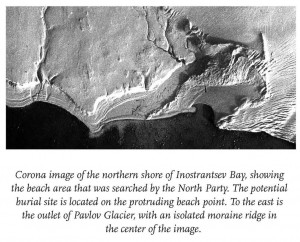 Friday, 25 August 1995 – “Bosun – topside!” The Captain’s command over the intercom aroused me from a deep sleep. Henri, jumping from his cot, rushed out to film the action on deck. Soon the muffled rattling of the anchor chain reverberated throughout the ship: we were dropping anchor. Slowly, I got up. Fleetingly, ever so fleetingly, a wave of revulsion suffused my body, and I tried not to think about what was outside: a fog-shrouded, ice-cold sea and a huge, empty island. I glanced at my watch: 7:15 a.m. Through the porthole I could see a calm sea, light blue under a low, grey sky. If this was Ivanov Bay, the grave search party would go ashore. If it wasn’t, only the Captain might know where on earth we may be. I got dressed and hurried outside. In the light, drizzly mist that engulfed the ship, Jerzy and Bas were siphoning gasoline into lemonade bottles from a big, rusty fuel barrel on the foredeck, using a rubber hose. Inside, the breakfast table had been set, but there was no time to eat. The landing of the grave-searchers was busily being prepared, as Boyarsky was threatening that the sea might soon get rough again. Only George, with aristocratic unconcern, sat sipping a cup of tea in the otherwise empty mess room. The corridors teemed with foot traffic. The hum of electric motors resonated through the steel vessel as the deck crane deposited a huge stack of wooden beams and planks from the hold into the landing craft. For protection against bears, the Ivanov Bay group would be constructing a hut for their stay. On deck, the atmosphere was frenzied and tension was palpable, with good-byes adding to the din of cargo handling.
Friday, 25 August 1995 – “Bosun – topside!” The Captain’s command over the intercom aroused me from a deep sleep. Henri, jumping from his cot, rushed out to film the action on deck. Soon the muffled rattling of the anchor chain reverberated throughout the ship: we were dropping anchor. Slowly, I got up. Fleetingly, ever so fleetingly, a wave of revulsion suffused my body, and I tried not to think about what was outside: a fog-shrouded, ice-cold sea and a huge, empty island. I glanced at my watch: 7:15 a.m. Through the porthole I could see a calm sea, light blue under a low, grey sky. If this was Ivanov Bay, the grave search party would go ashore. If it wasn’t, only the Captain might know where on earth we may be. I got dressed and hurried outside. In the light, drizzly mist that engulfed the ship, Jerzy and Bas were siphoning gasoline into lemonade bottles from a big, rusty fuel barrel on the foredeck, using a rubber hose. Inside, the breakfast table had been set, but there was no time to eat. The landing of the grave-searchers was busily being prepared, as Boyarsky was threatening that the sea might soon get rough again. Only George, with aristocratic unconcern, sat sipping a cup of tea in the otherwise empty mess room. The corridors teemed with foot traffic. The hum of electric motors resonated through the steel vessel as the deck crane deposited a huge stack of wooden beams and planks from the hold into the landing craft. For protection against bears, the Ivanov Bay group would be constructing a hut for their stay. On deck, the atmosphere was frenzied and tension was palpable, with good-byes adding to the din of cargo handling.
Freed from all its cables, our landing craft, a red steel barge five meters long, danced merrily atop the waves. Once the entire Ivanov gang had climbed down the rope ladders, the droning plashkot sailed rapidly into the haze. Bundled up in gear as if ready to go ashore myself, I stood in a light rain atop Kiriev’s bridge and followed the progress of the landing through binoculars. A trio of long, rustbrown walruses glided by the red craft through the pale blue sea. It was easy to distinguish their bristling snouts, which spit out a spray of condensation and water when the animals are surfacing. It was +4°C. Novaya Zemlya was just a dark strip of land, the elevations above ca. 100 m disappearing into the low clouds. There was little snow.
By 11:15 a.m., the Ivanov group was ashore. The landing craft delivered a second load and was hoisted aboard. Kiriev raised anchor, but would not sail towards Ice Harbor. It had been decided to seek shelter from a new storm in Inostrantsev Bay, on the west coast of the island. Excitement swept over the ship when, at noon, we saw the first unobtrusive iceberg float by: the entire oyage so far had not provided this many sights. The silent flotilla of blue sculptures grew by the hour, indicating the proximity of calving glaciers. Our arrival in Inostrantsev Bay was estimated for 3:00 p.m. The plan calls for a reconnaissance sortie with two groups along the beaches of the bay, to search for cairns. Boyarsky requests that we be specifically alert for objects indicating the presence of the ancient Pomors and the Nazis, who operated in greatest secrecy on these shores during their Arctic campaigns. The approaching landing put us back on the alert. Bas distributed ammunition for the rifles and reviewed the arms discipline. “Should a polar bear come after us and we decide to fire at him,” he instructed us, “we’ll follow our firing-range routine. The shooter kneels down and someone else counts the bear’s approach: fifty meters… forty meters… thirty meters… Don’t stare at the bear, but focus on his chest or on his shoulder. There will be three cartridges in the magazine. For reasons of safety, do not keep a cartridge in the chamber. Remember, the second man keeps additional ammo at the ready.”
Self-sufficiency is imperative for one venturing out in the Arctic, and it was high time to get my gear in order. (“Coming along?” Anton, our film director, would tell the viewer. Small kids start crying, young women turn off the TV.) What do I need? After polar bears, the unpredictable weather, which can change from quiet to severe in half an hour, is the greatest challenge. The land is barren and provides no shelter. There is no snow in which the stranded traveler could dig a shelter against the piercing winds. To be lightly equipped and able to move about swiftly, I packed the thin, reinforced Gore-Tex cover of the Navy-issue sleeping bag and a small stove, with a one-liter bottle of gasoline, enough for two weeks. High-grade gasoline is harder to come by in these parts of the world than diesel or kerosene but more practical because kerosene fuel oil has a flash point well above 40°C and won’t ignite easily in low-temperature environs. I took my down jacket, wrapped in a plastic bag, so I could leave my sleeping bag on board. I took wax for my boots, packages of instant soup, chocolate milk, and mashed potatoes. There would be sufficient meltwater on land, but just to be sure, I filled my canteen. On a waist belt, I carried the dagger and a pouch containing flare gun, GPS, a set of waterproof-packed batteries, a notebook with waterproof paper, and a pencil. I took some extra film and decided where to put everything: the rain gear fortunately has plenty of zippered pockets to stow away the many little items I need to keep track of.
The sea was calm: smooth as glass. The landing craft glided over in fifteen minutes and at 4:00 p.m. ground onto the steep, gravel beachfront. The sailors kept the engine running to maintain a solid lock while we disembarked. In clouds of smoke and steam, we climbed the steep ridge of loose gravel. Then, after reversing the propeller’s motion, the plashkot quickly retreated into the fog.
ISSA Proceedings 2006 ~ Pragma-Dialectics And The Function Of Argumentation
 1. Introduction: Pragma-Dialectics and the Aims of this Paper
1. Introduction: Pragma-Dialectics and the Aims of this Paper
During the last 25 years Frans van Eemeren and Rob Grootendorst have very impressively developed Pragma-Dialectics, i.e. a consensualistic theory of argumentative discourse, which sees the elimination of a difference of opinion as the aim of such discourses and of argumentation. Currently this is the most famous and most discussed approach in argumentation theory in the world.
In what follows I will discuss Pragma-Dialcetics mainly from an epistemological standpoint, i.e. what this theory has to tell us with respect to acquiring true or justified beliefs and knowledge.
Technical note: The discussion rules are the constructional core of Pragma-Dialectics; in addition to a few material changes and to stylistic improvements, these rules have undergone a change in numbering. In this text I will refer to their first English version (E&G 1984, p. 151-175) as “Ro1” etc. (“original (or old) rule no. 1”) and to their most recent statement (E&G 2004, pp. 135-157) as “Rs1” etc. (“Rule in ‘Systematic Theory of Argumentation’ no. 1”). The material changes regard, first, the possibilities of defending (or attacking) a premise (Ro9/Rs7 (E&G 1984, p. 168; 2004, p. 147 f.)); the originally included possibility of common observation has been deleted – which is surprising – and the originally lacking possibility of argumentatively defending a premise included, which is a clear improvement. The second and most important change concerns the argument schemes that may be used for defending a claim: originally only deductive arguments were permitted now non-deductive argument schemes have been added (Ro10/Rs8 (E&G 1984, p. 169; 2004, p. 150)) – a substantial improvement. The following discussion usually refers only to the best version.
2. The Aim of Argumentation and Argumentative Discourse: Elimination of a Difference of Opinion
The whole approach of Pragma-Dialectics is constructed starting from one central theorem about the function of argumentative discourse and argumentation in general. The aim of argumentative discourse and of argumentation, as these are seen and constructed by Pragma-Dialectics, is to eliminate a difference of (expressed) opinion (e.g. E&G 1984, p. 1; 1992, xiii; p. 10; 2004, pp. 52; 57; Eemeren et al. 1996, p. 277) or to resolve a dispute – where “dispute” is understood as: expressed difference of opinion (e.g. E&G 1984, pp. 2; 3; 151). This resolution has taken place if the participants both explicitly agree about the opinion in question. The central task of the theory is to develop rules for rational discussions or discourses; and the value of the rules to be developed is regarded as being identical to the extent to which these rules help to attain the goal of resolving disputes (E&G 1984, pp. 151; 152; cf. 2004, pp. 132-134).
This, obviously, is a consensualistic conception of argumentative discourse and of argumentation, which aims at an unqualified consensus, i.e. a consensus that is not subjected to further conditions.[i] Consensualism defines a clear aim for argumentation and argumentative discourse, which can be the basis for developing a complete argumentation theory, including criteria for good argumentation, good discourse, theory of fallacies, theory of argumentation interpretation, etc. Thus, consensus theory in general, and Pragma-Dialectics in particular, is a full-fledged approach to argumentation theory. Similar and competing full-fledged approaches are, first, the rhetorical approach, which sees convincing an addressee, i.e. creating or raising an addressee’s belief in a thesis, as the aim of argumentation (e.g. Perelman & Olbrechts-Tyteca 1958; Hamblin 1970; Tindale 2004), and, second, the epistemological approach, which sees generating the addressee’s justified belief in the argumentation’s thesis as the standard function of argumentation (e.g. Biro & Siegel 1992,; Feldman 1994; Goldman 1999, ch. 5; Johnson 2000; Lumer 1990; 1991; 2005/2006; Siegel & Biro 1997). As opposed to epistemological theories, both consensus theory and rhetoric aim at an unqualified belief (though in Pragma-Dialectics this is more an expression of a belief than the belief itself); but consensus theory then, unlike rhetoric, requires that both participants share this opinion. Read more
De onzichtbaarheid voorbij – De collectieve rechten van inheemse volkeren in Peru en Bolivia – I
Inleiding
Wie in Nederland aan Peru en Bolivia denkt, ziet de typische beelden voor zich van inheemse vrouwen met twee vlechten, kleurige rokken, en een hoed op het hoofd. Hoewel inderdaad in beide landen een groot deel van de bevolking inheems is, zijn deze mannen en vrouwen eeuwenlang onzichtbaar geweest op het politieke toneel. Dankzij de toegenomen aandacht voor de inheemse rechten op internationaal niveau en de versterking van de inheemse organisaties van onderaf, hebben de inheemse volkeren een steeds grotere rol in nationale processen verkregen. Opgenomen worden in de bestaande structuren is echter niet genoeg. De inheemse volkeren bevorderen nieuwe processen om vanuit hun eigen culturele en etnische diversiteit mee te kunnen besluiten. Zij willen geen van buitenaf opgelegde ontwikkelingsmodellen aannemen, maar zelf hun Buen Vivir(i)bepalen. Op deze manier dragen de inheemse volkeren bij aan een nieuwe uitleg van concepten als natiestaat, democratie en burgerschap. Read more
